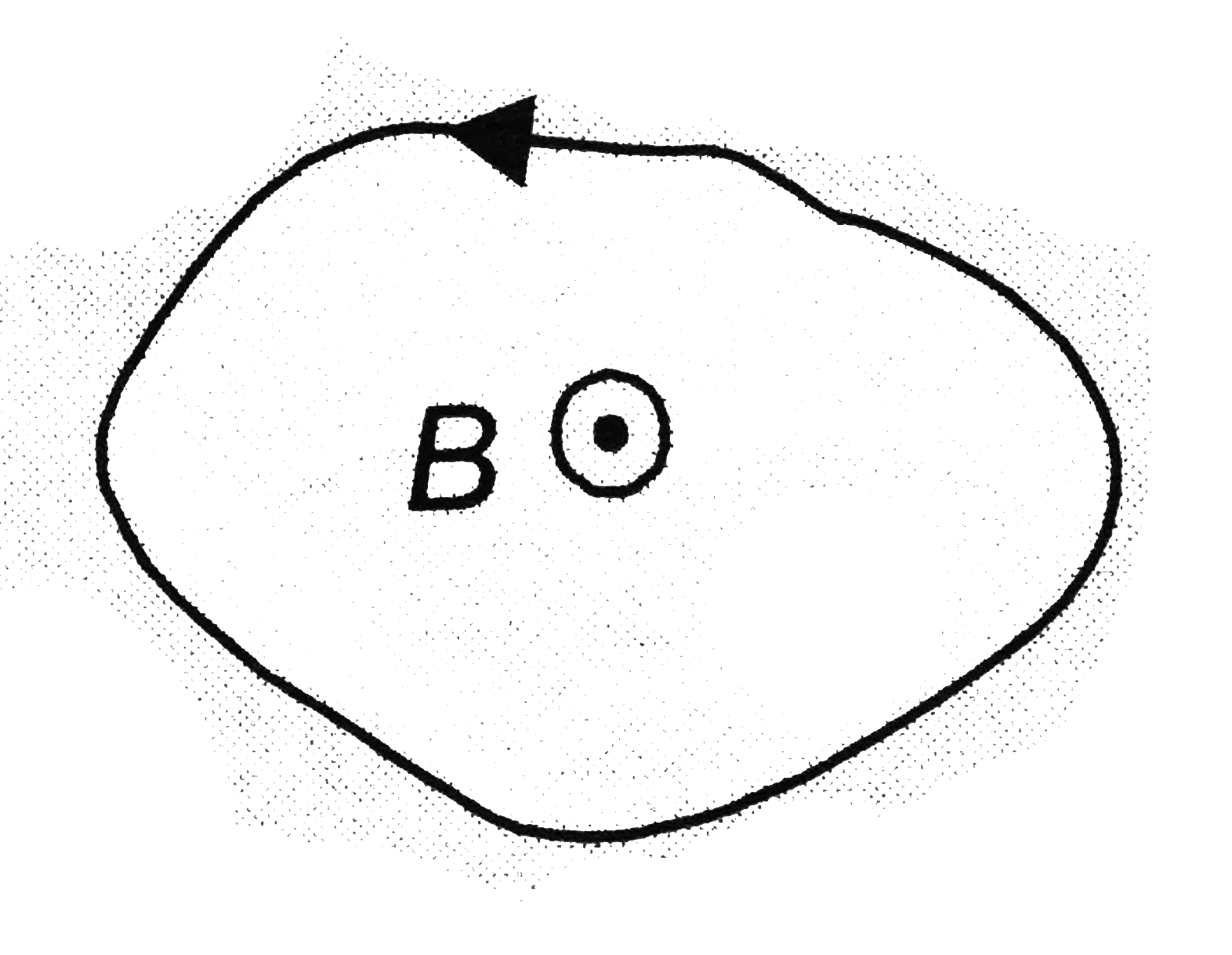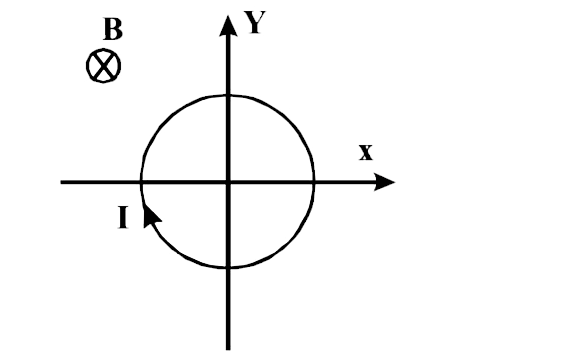A loop of flexible conducting wire of length l lies in magnetic field B which is normal to the plane of loop. A current l is passed through the loop. The tension developed in the wire to open up is
π2Bil
Bil2
Bil2π
Bil
The correct Answer is:c
To find the tension developed in a flexible conducting wire loop lying in a magnetic field when a current is passed through it, we can follow these steps:
1. Understand the Setup:
- We have a loop of flexible conducting wire of length l in a magnetic field B that is normal (perpendicular) to the plane of the loop.
- A current I flows through the loop.
2. Determine the Radius of the Loop:
- The circumference of the loop is equal to the length of the wire, so we have:
l=2πR
- From this, we can express the radius R as:
R=l2π
3. Consider the Forces Acting on the Loop:
- The magnetic force dFm acting on a small segment dl of the wire due to the current in a magnetic field is given by:
dFm=I⋅dl⋅B
- The direction of this force is vertical (upward) due to the right-hand rule.
4. Analyze the Tension in the Wire:
- Let T be the tension in the wire. The tension has both vertical and horizontal components. For a small angle dθ, the vertical components of tension on either side of the loop will be:
Tsin(dθ2)+Tsin(dθ2)=2Tsin(dθ2)
5. Equate the Forces for Equilibrium:
- For the loop to be in equilibrium, the total magnetic force must balance the vertical components of the tension:
dFm=2Tsin(dθ2)
- Substituting dFm:
I⋅dl⋅B=2Tsin(dθ2)
6. Express dl:
- The length dl can be expressed in terms of the radius R and the angle dθ:
dl=R⋅dθ
7. Substitute and Simplify:
- Substitute dl into the force equation:
I⋅(R⋅dθ)⋅B=2Tsin(dθ2)
- For small angles, we can approximate sin(dθ2)≈dθ2:
I⋅(R⋅dθ)⋅B=2T⋅dθ2
- This simplifies to:
I⋅R⋅B=T
8. Substitute R:
- Now substitute R=l2π:
T=I⋅(l2π)⋅B
- Thus, the tension T in the wire is:
T=I⋅l⋅B2π
Final Answer:
The tension developed in the wire to open up the loop is:
T=I⋅l⋅B2π
- We have a loop of flexible conducting wire of length l in a magnetic field B that is normal (perpendicular) to the plane of the loop.
- A current I flows through the loop.
- The circumference of the loop is equal to the length of the wire, so we have:
l=2πR
- From this, we can express the radius R as:
R=l2π
- The magnetic force dFm acting on a small segment dl of the wire due to the current in a magnetic field is given by:
dFm=I⋅dl⋅B
- The direction of this force is vertical (upward) due to the right-hand rule.
- Let T be the tension in the wire. The tension has both vertical and horizontal components. For a small angle dθ, the vertical components of tension on either side of the loop will be:
Tsin(dθ2)+Tsin(dθ2)=2Tsin(dθ2)
- For the loop to be in equilibrium, the total magnetic force must balance the vertical components of the tension:
dFm=2Tsin(dθ2)
- Substituting dFm:
I⋅dl⋅B=2Tsin(dθ2)
- The length dl can be expressed in terms of the radius R and the angle dθ:
dl=R⋅dθ
- Substitute dl into the force equation:
I⋅(R⋅dθ)⋅B=2Tsin(dθ2)
- For small angles, we can approximate sin(dθ2)≈dθ2:
I⋅(R⋅dθ)⋅B=2T⋅dθ2
- This simplifies to:
I⋅R⋅B=T
- Now substitute R=l2π:
T=I⋅(l2π)⋅B
- Thus, the tension T in the wire is:
T=I⋅l⋅B2π
The tension developed in the wire to open up the loop is:
T=I⋅l⋅B2π
Topper's Solved these Questions
- BOOK - CENGAGE PHYSICS ENGLISHCHAPTER - MAGNETIC FIELD AND MAGNETIC FORCESEXERCISE - Exercises Multiple Correct25videos
MAGNETIC FIELD AND MAGNETIC FORCES
- BOOK - CENGAGE PHYSICS ENGLISHCHAPTER - MAGNETIC FIELD AND MAGNETIC FORCESEXERCISE - Exercises Assertion -reasoning8videos
MAGNETIC FIELD AND MAGNETIC FORCES
- BOOK - CENGAGE PHYSICS ENGLISHCHAPTER - MAGNETIC FIELD AND MAGNETIC FORCESEXERCISE - Exercises Subjective10videos
MAGNETIC FIELD AND MAGNETIC FORCES
- BOOK - CENGAGE PHYSICS ENGLISHCHAPTER - INDUCTANCEEXERCISE - Concept Based8videos
INDUCTANCE
- BOOK - CENGAGE PHYSICS ENGLISHCHAPTER - MISCELLANEOUS VOLUME 3EXERCISE - True and False3videos
MISCELLANEOUS VOLUME 3
Similar Questions
A loop of flexible conducting wire of length 0.5 m lies in a magnetic field of 1.0 T perpendicular to the plane of the loop. Show that when a current as shown in Fig. 1.112 is passed through the loop, it opens into a circle. Also calculate the tension developed in the wire if the current is 1.57 A.
 View Solution
View SolutionA square conducting loop of side length L carries a current I.The magnetic field at the centre of the loop is
View SolutionA circular loop carrting a current a current I has wire of total length L. A uniform umagnetic field B exists parallel to the plane of the loop. (a ) find the trouque on the loop.(b) If the sme length of the wire is used to form a squar loop, what would be the torque? Which is larger?
View SolutionA circular loop of radius R is kept in a uniform magnetic field pointing perpendicular into the plane of paper. When a current l flows in the loop, the tension produced in the loop is
 View Solution
View SolutionA metallic loop is placed in a magnetic field. If a current is passed through it, then
View SolutionA square conducting loop of side length L carries a current I.The magnetic field at the centre of the loop is (dependence on L)
View SolutionA triangular loop of side l carries a current l. It is placed in a magnetic field B such that the plane of the loop is in the direction of B. The torque on the loop is
View SolutionA triangular loop of side l carries a current I. It is placed in a magnetic field B such that the plane of the loop is in the direction of B. The torque on the loop is
View SolutionA conducting loop carrying a current I is placed in a uniform magnetic field ponting into the plane of the paper as shown. The loop will have a tendency to
 View Solution
View SolutionA square loop of side L, resistance R placed in a uniform magnetic field B acting normally to the plane of the loop. If we attempt to pull it out of the field with a constant velocity v, then the power needed is
View Solution

